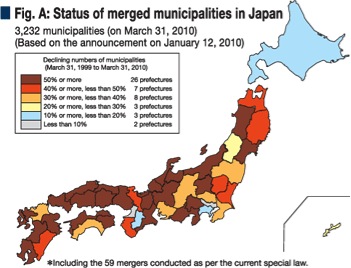The Heisei mergers are long done and Japan has turned to vitalizing its rural economy. The question is whether such a policy will work.
Memo #331
By Anthony Rausch – asrausch [at] cc.hirosaki-u.ac.jp
 The current focus on regional vitalization by the Abe Cabinet reflects Japanese concern with its dropping rural population and Tokyo-centered economy. The question facing Japan is whether the policy that has been crafted to achieve vitalization is simply a repeat of the municipal mergers of a decade ago.
The current focus on regional vitalization by the Abe Cabinet reflects Japanese concern with its dropping rural population and Tokyo-centered economy. The question facing Japan is whether the policy that has been crafted to achieve vitalization is simply a repeat of the municipal mergers of a decade ago.
The Heisei mergers, the municipal mergers of the Heisei era (1989~), undertaken from 2000 to 2006, represented a neo-liberal response to the perceived fiscal ineffectiveness of Japan’s developmental state economy. Pre-mergers, the central government subsidized over 3,000 local economies through massive infrastructural development funded by tax reallocations. The Heisei mergers program rewarded municipalities—cities, towns and villages—that merged, bringing the number down to 1,700. Ten years on, while the aims of budget streamlining and reduction have been attained, the mergers have also yielded local service inequalities and loss of security for many local residents, as it is now clear that advantaged municipalities attracted partners and prosper (which they would have regardless), while disadvantaged municipalities, even those that merged, still struggle.
The Abe Cabinet is now adopting a similar approach to regional revitalization, calling on municipalities to outline a “strategic vitalization plan” to cultivate local industry through small-scale enterprises, capitalize on local “originality,” and to ensure sufficient residents. However, the reality for local places is much more complex, if not problematic. Rural places often need “vitalization” precisely because they are rural places; a lack of economic dynamism—innovative industry, for example—is inescapable and the options of vitalization strategies are few.
Regional vitalization as national policy will likely ultimately yield the same result as the Heisei mergers. The lesson that should have been learned from the mergers is that perhaps the best that can be negotiated for many rural areas is “managed continuity,” where the trajectory of a disadvantaged locale is managed, with national-level support, so as to minimize the inequality in service for locals and image for tourism vis a vis more advantaged places. As more and more urbanites recognize the “lifestyle value” of non-urban locales, long-term regional vitalization may best be envisioned as ensuring that regional areas simply survive.
About the Author:
Anthony S. Rausch is a professor at Hirosaki University, Japan.

Figure showing decline from 3.232 municipalities as of March 31, 1999 to 1,727 as of March 31, 2010 (Source: http://www.soumu.go.jp/english/lab/).
Links:
- Anthony Rausch, “Municipal Mergers in Rural Japan: Easy on the Powerful, Severe on the Weak,” electronic journal of contemporary japanese studies (2005)
- Yomiuri Shimbun, “Regionalism Revitalizes Japan,” Volumes 1-4, Yomiuri Online
- Anthony Rausch, “Japan’s Heisei municipal mergers and the contradictions of neo-liberal administrative planning,” Asia Pacific Journal of Public Administration, 36-2 (2014)
- Peter Matanle and Anthony Rausch, Japan’s Shrinking Regions in the 21st Century: Contemporary Responses to Depopulation and Socioeconomic Decline (Cambria Press, 2011)
- Japan for Sustainability, “Study Shows Growing Number of Young Japanese Urbanites Want to Settle in Rural Areas,” Japan for Sustainability (October 2014)
Related Memos:
See our other memos on Japan.
Comments are closed, but trackbacks and pingbacks are open.